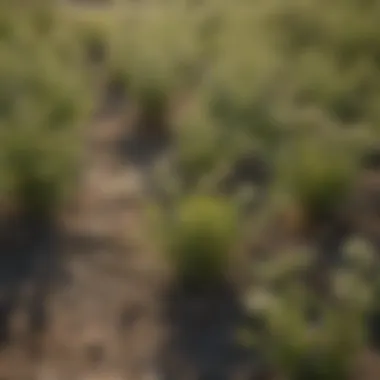Common Weeds in Texas: Identification & Management


Overview of the Topic
Definition and Importance
Weeds are unwanted plants that compete with crops for resources like nutrients, water, and sunlight. In Texas, where agriculture is a vital part of the economy, understanding and managing these common weeds is essential. Weeds can hinder crop growth and ultimately reduce yields, leading to economic losses for farmers. Therefore, identifying these plants and understanding their growth patterns is crucial for effective management.
Current Trends
The landscape of agriculture in Texas is changing due to various factors including climate change, crop rotation practices, and herbicide resistance. Farmers and agronomists must adapt their weed management strategies in response to these developments. For instance, some weeds are becoming more prevalent due to changing weather patterns. Knowledge of how these weeds behave and adapt is necessary for sustainable farming practices.
Key Techniques and Practices
Step-by-Step Guide
- Identification of Weeds: Farmers should regularly inspect their fields to identify weeds. Knowledge of specific weed characteristics is vital. This includes their leaf shapes, growth habits, and flowering times.
- Assessment of Weeds: Once identified, assess the density and distribution of the weeds. This will help in determining the severity of the infestation.
- Choice of Management Strategy: There are several methods available for managing weeds. These include mechanical removal, chemical treatments, and cultural practices. Each method has its benefits and challenges.
- Implementation: Execute the chosen management strategies at the right time. Timing can significantly impact the effectiveness of weed control methods.
- Monitoring and Evaluation: Continuous monitoring of weed populations is necessary to adapt strategies as needed and ensure long-term effectiveness.
Tools and Equipment Needed
- Hand Tools: Hoes and trowels are useful for small-scale removal of weeds.
- Mowers and Tractors: For larger areas, mechanical tools can help in cutting back weeds.
- Herbicides: Chemical solutions can provide relief from aggressive weed infestations, but must be used carefully to avoid harming crops.
- Protective Gear: Always use gloves and masks when handling chemicals for safety.
Challenges and Solutions
Common Obstacles
Weed management faces several challenges, including:
- Herbicide Resistance: Some weeds have developed resistance to common herbicides, making them harder to control.
- Resource Limitation: Small-scale farmers may not have the resources to invest in advanced management systems.
- Environmental Impact: Over-reliance on chemicals can lead to negative impacts on the surrounding ecosystem.
Innovative Solutions
To combat these challenges, various innovative solutions can be considered:
- Integrated Weed Management (IWM): This approach combines multiple strategies, such as mechanical, cultural, and chemical controls, to manage weed populations.
- Soil Health Improvement: Focusing on soil health can boost crop resilience against weeds and reduce infestations.
- Technology Utilization: Using drones and precision agriculture tools can enable better monitoring and targeted treatment of weed problems.
"Effective weed management is not just about eradication, it's about sustainable practices that allow crops to thrive."
By grasping the intricacies of weed identification and management, agricultural stakeholders in Texas can ensure that their practices not only optimize yields but also promote a balanced ecosystem. As this article unfolds, we will explore the most common weeds in Texas, their identification, and proactive management. Through better awareness and informed strategies, the challenges posed by invasive species can be effectively navigated.
Intro to Weeds in Texas
Understanding weeds in Texas is crucial for effective agricultural practices. Weeds can significantly influence crop yields and biodiversity within an ecosystem. This section lays the foundation for recognizing the challenges posed by these invasive species and highlights the significance of weed identification in managing them.
Defining Weeds
Weeds are plants that grow where they are not wanted. They can be native or non-native species, with the potential to harm crops by competing for resources such as water, nutrients, and light. The defining characteristic of a weed is its ability to thrive in various environments, often leading to uncontrollable growth.
In Texas, the climate and soil conditions favor the proliferation of various weed species. Some of these species have adapted well to the local ecology, further complicating management efforts. Recognizing what specifically constitutes a weed is the first step in effective management.
The Importance of Identifying Weeds
Accurate weed identification is essential for several reasons. First, knowing the specific species of weed helps determine the best control methods. Different weeds may require tailored approaches for effective management. For example, the herbicide that works on Crabgrass may not be effective on Dandelion.
Second, identifying weeds assists in understanding their life cycles. This knowledge enables farmers and gardeners to time their interventions effectively, maximizing control while minimizing costs.
Finally, weeds impact soil health. Certain species deplete soil nutrients, disrupting the natural balance. Identifying these weeds can help in developing a strategy to restore soil health, ensuring sustainability in agricultural practices. Understanding the relevance of weeds in Texas agriculture is a crucial part of effective management strategies.
Ecological Impact of Weeds
The ecological impact of weeds extends far beyond their visible presence in agricultural lands. Understanding these effects is crucial in forming effective management strategies. Weeds can alter ecosystems, disrupt food webs, and even impact soil health. The significance of assessing these impacts provides insight into both sustainable practices and the necessity for control mechanisms to protect crops and biodiversity.
Weed Competition with Crops
Weeds compete vigorously with crops for essential resources such as water, nutrients, and sunlight. This competition can lead to significant yield reductions for farmers. In Texas, crops like corn, cotton, and sorghum face threats from prevalent weeds such as crabgrass and dandelions. These weeds grow rapidly and can outpace the crops in nutrient uptake.
Weeds often have adaptations that make them more resilient than cultivated plants. For instance, they may develop deep root systems that access subsoil moisture, leaving crops deprived during dry spells. This nutrient competition can also affect the quality of the harvested crops. A greater focus on identifying these weeds allows farmers to implement timely interventions, reducing potential losses.
"Weeds, even when submerged in field management plans, always remind us of their resilience and ability to adapt."
Effective weed management practices, such as crop rotation and mulching, can alleviate this issue. These practices are essential in reducing weed pressure and enhancing crop productivity.
Weed Influence on Biodiversity


Weeds play a complex role in shaping biodiversity within ecosystems. While some may provide habitat and food for various organisms, uncontrolled weed growth can lead to a decline in native plant species. This situation creates a chain reaction affecting animal populations that rely on those plants.
In the context of Texas, where native flora and fauna are already at risk, invasive weed species pose a significant threat. For instance, bindweed can outcompete native plants, leading to a loss of plant diversity. This reduction directly impacts insects, birds, and other wildlife that depend on those plants for sustenance.
Maintaining a balance between managing weed populations and promoting healthy ecosystems is vital. Encouraging native plant growth can help restore ecological balance. Integrating biodiversity considerations into weed management strategies not only protects crops but also sustains the surrounding natural environment. Understanding these influences is key for anyone involved in agriculture and ecological conservation.
Common Weeds Found in Texas
Understanding the common weeds found in Texas is crucial for farmers and horticulturists. Weeds can significantly impact agricultural practices, reducing crop yields and increasing management costs. Identifying these weeds allows for targeted control measures, ultimately promoting healthier and more productive farming systems.
The variety and prevalence of weeds in Texas are notable due to the region's diverse climate and soil types. Knowledge of individual weeds empowers farmers to select effective management strategies tailored to specific weed characteristics. Effective weed management ensures better nutrient availability for crops, enhances biodiversity, and minimizes the reliance on chemical controls.
The Dandelion
Dandelions are widespread in Texas, recognized by their bright yellow flowers and jagged leaves. They thrive in disturbed areas, often appearing in lawns and agricultural fields. The root system of dandelions can penetrate deeply into the soil, making them resilient but also competitors for nutrients and moisture.
Controlling dandelions requires persistence. Regular mowing may reduce flower production. However, for complete eradication, hand-pulling the entire root during the spring or fall is most effective.
Crabgrass
Crabgrass is another common weed, often found in lawns and crop fields. It has a distinctive sprawling growth habit, which allows it to spread quickly. Crabgrass germinates under warm conditions and can outcompete crops for sunlight and nutrients.
Preventing crabgrass growth can be done through proper lawn maintenance, such as keeping grass healthy and thick to outcompete it. Pre-emergent herbicides also work well in the spring before crabgrass seeds can germinate.
Yellow Sedge
Yellow sedge is frequently found in wet areas across Texas, recognizable by its grass-like appearance. This weed can thrive in both dry and wet conditions, making it a versatile competitor. Yellow sedge produces nutlets which can spread easily and maintain a persistent seed bank in the soil.
Management of yellow sedge involves consistent mowing and the use of specific herbicides effective against sedges. It is crucial to identify this weed early to prevent its spread into valuable crop areas.
Purslane
Purslane is a succulent that grows in various environments, often appearing in gardens and agricultural settings. It is characterized by its fleshy, red stems and small yellow flowers. Purslane thrives in hot, dry weather, making it a summer nuisance in Texas.
Controlling purslane can be challenging due to its ability to reproduce from stem fragments. Hand-pulling combined with mulch application can reduce populations significantly. Additionally, using non-selective herbicides can be effective where appropriate.
Bindweed
Bindweed is a perennial weed recognizable by its twining vines and heart-shaped leaves. This weed can quickly entangle itself around desirable plants, suffocating them and preventing growth. Bindweed is notorious for its deep root systems, making it difficult to eliminate.
Management of bindweed often requires persistent effort. Regular cultivation can help disturb its growth, but a combination of mechanical removal and targeted herbicide application often yields better results.
Effective weed management enhances crop yield and keeps agriculture sustainable in Texas.
In summary, knowledge of these common Texas weeds — dandelion, crabgrass, yellow sedge, purslane, and bindweed — is key to effective management. Each of these weeds presents unique challenges and may require tailored management strategies for successful control. Understanding their growth habits and response to control measures will help farmers and agricultural enthusiasts maintain healthy crops.
Growth Patterns of Texas Weeds
Understanding the growth patterns of weeds is vital for effective management and control. Knowing how these plants develop, their life cycles, and the conditions that favor their growth helps farmers and enthusiasts in making informed decisions about weed management strategies. Moreover, these patterns can inform the timing of interventions, whether cultural, mechanical, or chemical, ensuring they are applied when they will be most effective.
Weeds thrive in various conditions, and their adaptability can complicate control efforts. By examining weed growth patterns, we can identify trends that may help in anticipating their behaviors and addressing them proactively.
Life Cycles of Common Weeds
Weeds can be classified into annual, biennial, and perennial based on their life cycles. Each type has distinct growth habits and management needs.
- Annual Weeds quickly complete their life cycle within one growing season. Examples include crabgrass and foxtail. They germinate, grow, flower, and die in a single year. Their rapid life cycle allows them to establish quickly, taking advantage of conditions that may be unfavorable for more permanent plants.
- Biennial Weeds require two growing seasons to complete their life cycle. They typically grow vegetatively in the first year, overwintering as a rosette or seedling, then flowering and setting seeds in the second year. An example is burdock. Understanding the biennial life cycle is crucial for timing control efforts effectively, especially during the first year.
- Perennial Weeds live for more than two years. These tough plants, such as bindweed and dandelion, often have deep root systems that make them challenging to control. They can reproduce through seeds, root fragments, or rhizomes. Managing perennial weeds often requires sustained efforts, including methods that target the root systems.
Seasonality and Growth Conditions
The growth of Texas weeds is heavily influenced by the state’s climatic conditions. Seasonal changes affect when weeds germinate, grow, and reproduce.
- Spring is a crucial period for many annual weeds as they emerge rapidly after cold months. Warm weather and increased moisture can spur growth. Farmers should monitor fields closely during this time for signs of weed emergence.
- Summer often sees the peak growth of weeds such as crabgrass, which thrives in hot weather. Effective management includes regular mowing and herbicide applications to prevent seed production.
- Fall can trigger growth in biennial weeds, making it essential to manage them early in the season before they establish deep roots.
- Winter is typically a dormant phase. However, some weeds manage to survive in milder areas. It’s a good time for farmers to plan for the next growing season by evaluating weed pressures.
Soil health and proper nutrient levels also determine weed growth. Weeds favor disturbed and nutrient-rich soils, often found in areas that have been recently tilled or where crops have been harvested. Practices like cover cropping and maintaining soil health can reduce the likelihood of weed proliferation.
"Weed management is not just about removal; it is about understanding growth patterns and adapting strategies accordingly."
Factors Contributing to Weed Proliferation
Understanding the factors that contribute to weed proliferation is essential for effective management strategies. Weeds are not just random plants; they thrive under specific conditions, often influenced by agricultural practices and environmental factors. Identifying these elements can provide farmers and agronomists with tools to mitigate the negative impacts of invasive weeds on crops and ecosystems.
Soil Health and Nutrient Levels


Soil health plays a critical role in weed growth. Healthy soil promotes the growth of crops while minimizing conditions that favor weeds. When soil is nutrient-rich and has good structure, desired plants can thrive more readily, leaving less room for weeds. Conversely, depleted soil often provides the perfect environment for weeds to take over.
- Nutrient Imbalance: Weeds often adapt better to nutrient imbalances in soil. They can utilize nitrogen better than many crops, leading to their rapid proliferation.
- pH Levels: Weeds often prefer different pH levels compared to cultivated crops. For instance, many weeds favor slightly acidic to neutral soils, while certain crops prefer more alkaline conditions. Adjusting soil pH can contribute to managing weeds.
- Organic Matter: High levels of organic matter in soil improve overall health and can suppress weed growth. Incorporating compost or utilizing cover crops can enhance organic materials in the soil.
To enhance soil conditions:
- Regularly test soil nutrients.
- Rotate crops to maintain nutrient levels.
- Incorporate cover crops to improve organic content.
Climate Variability
Climate variability is another significant contributor to weed proliferation. Changes in climate patterns create opportunities for weeds to emerge and thrive. Temperature fluctuations, precipitation changes, and invasive species are key areas of concern.
- Temperature Changes: Weeds often have wider temperature tolerances compared to cultivated crops. This allows them to proliferate in areas where crops may struggle to survive.
- Rainfall Patterns: Increased rainfall can lead to soil erosion and create conditions suitable for weed seeds to germinate. Conversely, drought stress on crops can make them more susceptible to weed competition.
- Invasive Species: Climate can also facilitate the spread of invasive weed species that thrive in altered environments. These species often outcompete native plants and crops, making management increasingly difficult.
"The impact of climate on weed dynamics is a reminder that managed agricultural systems need to adapt to both climate and soil conditions for long-term sustainability."
Weed Management Strategies
Weed management strategies are critical in maintaining the health and productivity of agricultural lands in Texas. By using various techniques effectively, farmers can minimize the impact of invasive species. Proper management helps prevent crop loss, improves soil health, and enhances overall biodiversity. Additionally, the right strategies can lead to a more sustainable agricultural practice, balancing productivity with ecological responsibility.
Cultural Controls
Cultural controls involve practices that can suppress weed growth through changes in agricultural management. Education on soil health, for example, is crucial. Healthy soils have better organic matter content, which can outcompete weeds. Farmers can also choose appropriate planting dates to allow crops to establish before weeds emerge.
Other effective cultural control methods include:
- Crop rotation: Alternating crops can disrupt weed life cycles.
- Cover crops: Planting certain crops in the off-season will prevent weeds from establishing.
- Mulching: Organic or inorganic mulch can block light needed for weed growth.
Understanding the local ecosystem and selecting crops that are more competitive against prevalent weeds can significantly reduce their rates of proliferation.
Mechanical Controls
Mechanical controls focus on removing weeds through physical methods. This can be as simple as hand-pulling small infestations or using tools like hoes and cultivators for larger areas. Tilling is another common technique that can disrupt weed establishment, but care must be taken to minimize soil disturbance.
When using mechanical controls, timing is crucial. If farmers can target weeds early in their growth and before they set seeds, they can significantly reduce future populations. However, over-reliance on tillage can lead to soil erosion and compaction. Finding the right balance is important.
Chemical Controls
Chemical controls utilize herbicides to manage weed populations effectively. While they can be very effective, they must be used judiciously to prevent resistance development and minimize environmental impact. Selecting the right herbicide involves understanding the weed species present, their life cycles, and the crops in which they are used.
Some important considerations when employing chemical controls include:
- Application Timing: It is essential to apply herbicides at the right growth stage for maximum effectiveness.
- Soil and Weather Conditions: Certain chemicals need specific conditions to work effectively.
- Alternating Herbicides: Using different modes of action can help prevent resistance.
Farmers should always follow integrated pest management principles to ensure that the use of chemical controls complements other strategies, creating a holistic approach to weed management.
Effective weed management is not solely reliant on any single approach. It necessitates a combination of cultural, mechanical, and chemical methods to ensure lasting results.
Sustainable Practices for Weed Management
In the context of Texas agriculture, sustainable practices for weed management are essential. The land in this region faces challenges from invasive species. Implementing sustainability helps to mitigate these challenges. These practices aim to control weeds while maintaining the health of the ecosystem.
Key aspects of sustainable weed management include reduced chemical usage, improved soil health, and promoting biodiversity. Each approach contributes to the long-term viability of farmland. This makes it crucial to adopt these strategies in order to achieve efficient production without compromising the environment.
The benefits of using sustainable practices are multifaceted:
- Soil Improvement: Healthier soil enhances plant growth and reduces weed competition.
- Biodiversity Boost: By supporting a wider range of species, ecosystems become more resilient to pests and diseases.
- Cost Effectiveness: Over time, reduced reliance on herbicides can lower expenses related to weed control.
The considerations for adopting these practices include local environmental conditions and specific crop requirements. Understanding these factors can lead to more effective implementation. Farmers should evaluate their individual situations before committing to a particular practice.
Cover Cropping
Cover cropping is one prominent sustainable practice. This method involves planting crops that will not be harvested. Instead, they serve to cover the soil. One main purpose of cover crops is to suppress weed growth. When properly managed, these crops can significantly reduce the number of weeds in subsequent growing seasons.
Cover crops provide numerous benefits:
- Weed Suppression: Cover crops outcompete weeds for resources, thus limiting their growth.
- Nutrient Cycling: They can improve nutrient availability in the soil, boosting the health of the following crops.
- Erosion Control: With their root systems, cover crops stabilize the soil, preventing erosion during heavy rains.
Farmers must choose the right cover crop based on their primary crop and climatic conditions. Some popular choices include clover, rye, and vetch. Each has unique qualities that can benefit specific situations.
"Utilizing cover crops can lead to an adaptive strategy for increasing overall farm productivity and resilience through weed suppression."
Crop Rotation


Crop rotation is another effective sustainable practice. This involves changing the type of crop grown in a specific area from season to season. It helps manage weed populations by breaking their life cycles. Each crop type attracts different pests and diseases, which can keep weeds in check.
The advantages of crop rotation include:
- Diversity in Management: Weeds that thrive in specific crops may not adapt well to different ones.
- Soil Fertility: Rotating crops often improves soil structure and nutrient levels. For instance, legumes can enhance nitrogen levels in the soil, which benefits subsequent crops.
- Reduced Pest Pressure: Different crops can disrupt pest cycles, adding another layer of control against weeds.
Farmers should plan their rotations carefully, considering how each crop interacts with weeds. This planning can significantly enhance weed control measures and lead to sustainable farming success.
The Role of Technology in Weed Control
Technology has become a vital component in modern agriculture, especially in the realm of weed management. The integration of advanced tools and methods enhances the efficiency and effectiveness of weed control practices. This section outlines how technology aids in identifying, monitoring, and managing common weeds in Texas.
Precision Agriculture
Precision agriculture represents a transformative approach in the management of crops and the surrounding environment. By utilizing technology such as GPS and data analytics, farmers can optimize their weed control efforts. This framework allows for targeted application of herbicides, minimizing both costs and environmental impact.
- Benefits of Precision Agriculture
- Resource Optimization: Farmers can apply chemicals only to areas with confirmed weed problems, conserving resources and reducing waste.
- Yield Improvement: Precision techniques promote healthier crops by protecting them from weed competition more effectively.
- Data Utilization: Collecting data helps in mapping weed infestations, leading to informed decision-making.
In essence, precision agriculture enhances management strategies, leading to a more sustainable agricultural practice.
Remote Sensing Techniques
Remote sensing techniques have emerged as powerful tools for monitoring weed populations and their effects on the agricultural landscape. These methods involve collecting data from a distance, often using drones or satellites, to assess vegetation health and detect weed infestations without the need for extensive physical inspections.
- Key Features of Remote Sensing:
- Early Detection: This technology enables farmers to spot weed infestations early, allowing prompt intervention.
- Comprehensive Coverage: Large areas can be surveyed quickly, providing data that would be difficult to gather manually.
- Continuous Monitoring: Regular updates on weed conditions help to adjust management practices dynamically.
"Technological advancements like remote sensing not only increase efficiency but also support decision-making processes in weed management."
Future Trends in Weed Management
The management of weeds has evolved in recent years due to new challenges and advances in technology. As agricultural practices face the strains of climate change, rising herbicide resistance, and the demand for sustainable food production, it's essential to explore future trends in weed management. By integrating innovative techniques that are both effective and environmentally friendly, farmers can enhance their productivity and resilience against common weeds in Texas.
Biological Control Methods
Biological control involves using natural predators or pathogens to manage weed populations. This method showcases the potential for sustainable practices by reducing reliance on chemical herbicides. The advantages of biological control include its long-term effectiveness and a lower environmental impact. For instance, utilizing specific insects that naturally feed on aggressive weeds can diminish the weed population without harming crops.
Some benefits of implementing biological control methods are:
- Reduced chemical use: This leads to less chemical runoff and a healthier ecosystem.
- Sustainable impact: Natural predators can continue to control weed populations over time.
- Targeted approach: Biological control can selectively target specific weeds while preserving beneficial plants.
Still, there are important considerations too. Biological control often requires significant initial research to identify effective species. It may take time for natural systems to establish, meaning immediate results are not always visible. Therefore, a well-planned introduction of biological agents is crucial to ensure a stable outcome.
Integrated Weed Management Approaches
Integrated weed management (IWM) combines various weed control methods to create a comprehensive strategy. This holistic approach ensures that multiple tactics work in tandem to combat weed growth. An effective IWM plan may include cultural practices, mechanical control, and careful application of herbicides, emphasizing flexibility and adaptability to suit local conditions.
Key components of IWM include:
- Cultural practices: Crop rotation, cover cropping, and adjusting planting schedules can disturb weed growth cycles.
- Mechanical controls: Tillage, mowing, and hand-pulling can physically remove weeds, effective particularly for small areas.
- Herbicide management: Thoughtful use of herbicides in rotation can help manage resistance.
The benefits of IWM are substantial:
- Resilience against resistance: By diversifying management strategies, the risk of herbicide resistance in weed populations decreases.
- Enhanced biodiversity: Supporting a range of plants and solutions can also enhance soil health and ecosystem benefits.
- Economic efficiency: Reducing herbicide applications helps lower operational costs, contributing to overall financial sustainability.
Closure
The conclusion of this article underscores the significance of understanding common weeds in Texas for effective weed management. Weeds can have a detrimental impact on agricultural productivity and biodiversity. Recognizing weed species helps in developing targeted management strategies that are not only efficient but also sustainable.
Summarizing Key Points
In summary, the critical elements of weed management covered in this article include:
- Identification of Common Weeds: An understanding of prevalent weeds like dandelion, crabgrass, yellow sedge, purslane, and bindweed is essential for effective control.
- Growth Patterns and Life Cycles: Knowledge of the life cycles and seasonal growth conditions of these weeds allows for timely interventions.
- Ecological Impact: Grasping how weeds compete with crops and influence biodiversity highlights the need for proactive management.
- Management Strategies: Various strategies, including cultural, mechanical, and chemical controls, have their roles in an integrated approach to weed management.
- Sustainable Practices: The inclusion of sustainable practices like cover cropping and crop rotation promotes long-term agricultural viability.
Final Thoughts on Weed Management
Weed management is not just about removing undesirable plants; it is about fostering a healthier agricultural ecosystem. Farmers and enthusiasts must employ an integrated approach, leveraging technology, sustainable practices, and comprehensive knowledge of local weed dynamics.
By staying informed and employing adaptive management techniques, producers can mitigate the challenges posed by these invasive species. The future of agriculture in Texas may depend on our ability to efficiently manage weeds, ensuring both productivity and environmental health.
"Weed management should not be an afterthought, but a proactive element of agricultural planning."
For more information on weed management strategies, further reading can be found at Wikipedia or Britannica.
This collective understanding paves the way for innovative solutions and sustainable agricultural practices.



